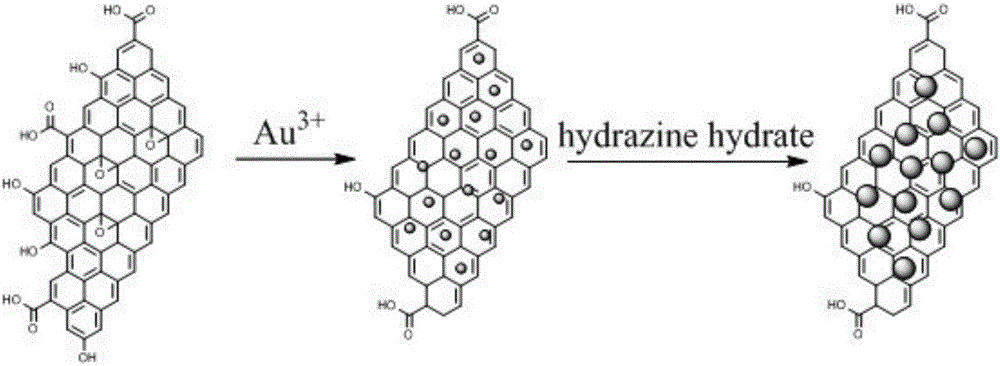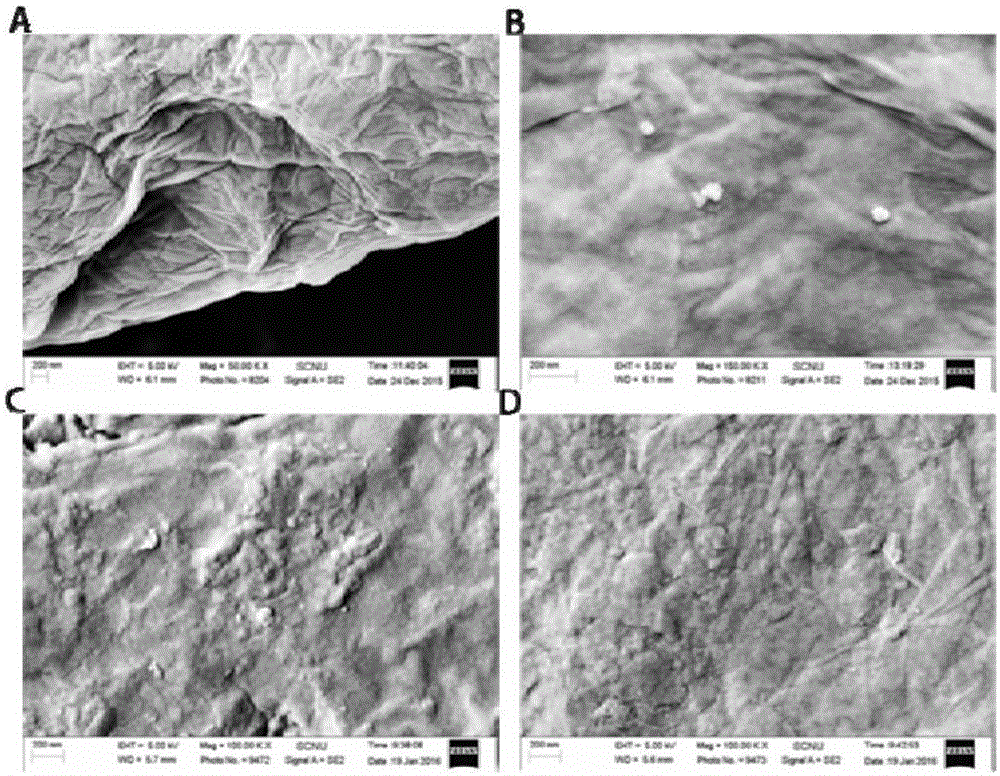Bisphenol A molecularly imprinted electrochemical sensor and preparation method and application thereof
A molecular imprinting and electrochemical technology, applied in the field of electrochemical detection, can solve the problems of poor recognition of target molecules, long antibody preparation time, large operating errors, etc., and achieve easy promotion, good reproducibility and stability, and wide linear range Effect
- Summary
- Abstract
- Description
- Claims
- Application Information
AI Technical Summary
Problems solved by technology
Method used
Image
Examples
Embodiment 1
[0029] A kind of preparation method of gold and reduced graphene oxide nanocomposite material:
[0030] Weigh 20 mg of graphene oxide, ultrasonically disperse in 20 mL of water for 1 hour, add 9.6 μM HAuCl 4 , the final volume of the solution is 40mL, magnetically stirred for 12 hours overnight; then heated to 80°C in an oil bath, continued to stir and added 60μL of hydrazine hydrate, and reacted at constant temperature for 3 hours; stopped the reaction, continued to stir and cooled to room temperature; centrifuged A black solid was obtained and vacuum-dried to obtain a gold and reduced graphene oxide nanocomposite product. Its reaction process is as figure 1 shown. The obtained product was identified by scanning electron microscopy, and the results were as follows: image 3 As shown in A and B, the modified reduced graphene oxide has gold nanoparticles on its surface.
Embodiment 2
[0032] A method for preparing a molecularly imprinted electrochemical sensor:
[0033] (1) Use 0.3μm and 0.05μm Al on the glassy carbon electrode in sequence 2 o 3 The powder was polished on suede, and after cleaning, it was ultrasonically washed in absolute ethanol and ultrapure water, and then dried in a beaker.
[0034] (2) Weigh 5 mg of the gold obtained in Example 1 and the reduced graphene oxide nanocomposite material, and ultrasonically disperse them in DMF / water (volume ratio 1:1) for 1.5 hours to prepare a dispersion.
[0035] (3) Take 5 μL of the dispersion obtained in step (2) with a pipette gun, drop it on the surface of the electrode, dry it in an oven at 50°C, rinse it with ultrapure water and dry it in the air to obtain Au / rGO / GCE.
[0036] (4) Au / rGO / GCE is used as the working electrode, the platinum sheet is used as the counter electrode, and saturated calomel is used as the reference electrode to form a three-electrode working electrolytic cell; the three e...
Embodiment 3
[0039] Using the bisphenol A molecularly imprinted electrochemical sensor obtained in Example 2 to detect bisphenol A comprises the following steps:
[0040] The bisphenol A molecularly imprinted electrochemical sensor was placed in a bisphenol A phosphate buffer solution (pH 6 .9), after soaking for 15 minutes, take it out and rinse it with ultrapure water, put it into the electrolytic cell for differential pulse voltammetry scanning, the scanning potential is 0.3-0.8V, the potential increment is 0.004V, and the pulse width is 0.05V , with an amplitude of 0.2V. After each scan, the bisphenol A molecularly imprinted electrochemical sensor was placed in the blank bottom solution for cyclic scanning until there was no peak, rinsed with water and dried, and the operation was repeated. Its operation diagram is as figure 2 As shown, the result is as Figure 5 , the detection linear range of the molecularly imprinted electrochemical sensor to bisphenol A is 2.50×10 -7 M-1.75×10...
PUM
| Property | Measurement | Unit |
|---|---|---|
| Concentration | aaaaa | aaaaa |
Abstract
Description
Claims
Application Information
 Login to View More
Login to View More - R&D
- Intellectual Property
- Life Sciences
- Materials
- Tech Scout
- Unparalleled Data Quality
- Higher Quality Content
- 60% Fewer Hallucinations
Browse by: Latest US Patents, China's latest patents, Technical Efficacy Thesaurus, Application Domain, Technology Topic, Popular Technical Reports.
© 2025 PatSnap. All rights reserved.Legal|Privacy policy|Modern Slavery Act Transparency Statement|Sitemap|About US| Contact US: help@patsnap.com



